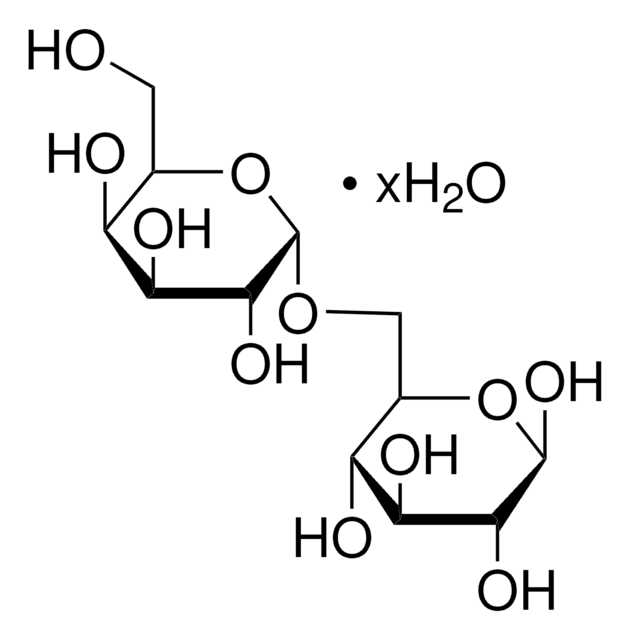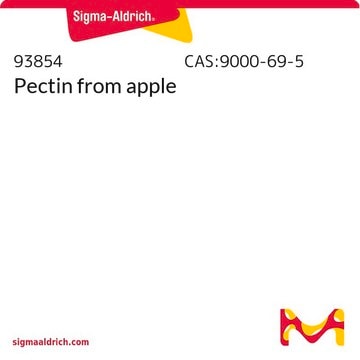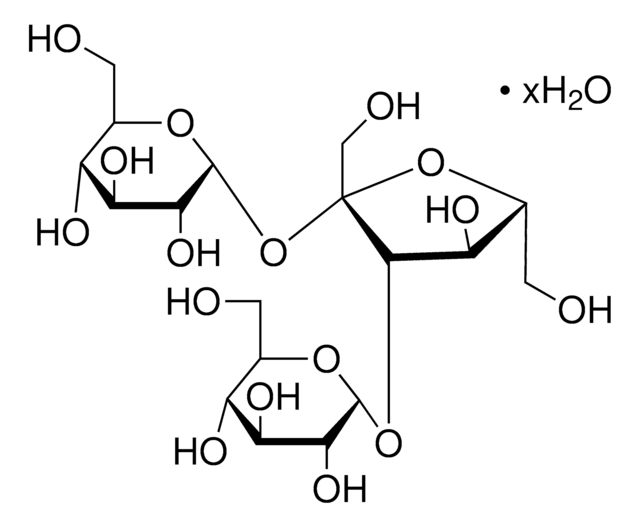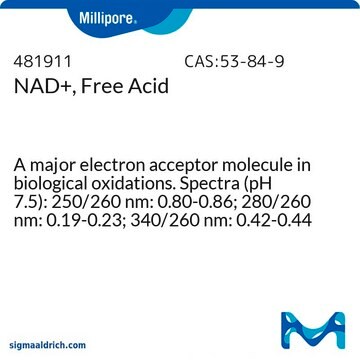63630
D-(+)-Melibiose
suitable for microbiology, ≥99.0%
Sinónimos:
Raffinose, Melizitose, α-D-Galactosyl-(1→6)-α-D-glucopyranoside, Galactosyl D-glucose, Galactosylglucose, D-Galactopyranosyl-(1→6)-D-glucose, Melibiose, Galactinol, D-(+)-Galactosyl-(1→6)-D-(+)-glucose, α-D-Gal(1→6)β-D-Glc, 6-O-α-D-Galactopyranosyl-D-glucose
Seleccione un Tamaño
162,00 €
Seleccione un Tamaño
About This Item
162,00 €
Productos recomendados
Nivel de calidad
Ensayo
≥99.0% (HPLC)
≥99.0%
Formulario
powder
actividad óptica
[α]20/D +137±3°, 10 hr, c = 5% in H2O
envase
pkg of 10 g
pkg of 50 g
residuo de ign.
≤0.1% (as SO4)
color
colorless to white
solubilidad
H2O: 0.1 g/mL, clear, colorless
trazas de anión
chloride (Cl-): ≤50 mg/kg
sulfate (SO42-): ≤200 mg/kg
trazas de catión
As: ≤0.1 mg/kg
Ca: ≤500 mg/kg
Cd: ≤5 mg/kg
Co: ≤5 mg/kg
Cr: ≤5 mg/kg
Cu: ≤5 mg/kg
Fe: ≤10 mg/kg
K: ≤50 mg/kg
Mg: ≤10 mg/kg
Mn: ≤5 mg/kg
Na: ≤50 mg/kg
Ni: ≤5 mg/kg
Pb: ≤5 mg/kg
Zn: ≤5 mg/kg
aplicaciones
microbiology
cadena SMILES
OC[C@H]1O[C@H](OC[C@@H](O)[C@@H](O)[C@H](O)[C@@H](O)C=O)[C@H](O)[C@@H](O)[C@H]1O
InChI
1S/C12H22O11/c13-1-4(15)7(17)8(18)5(16)3-22-12-11(21)10(20)9(19)6(2-14)23-12/h1,4-12,14-21H,2-3H2/t4-,5+,6+,7+,8+,9-,10-,11+,12-/m0/s1
Clave InChI
AYRXSINWFIIFAE-GFRRCQKTSA-N
¿Está buscando productos similares? Visita Guía de comparación de productos
Categorías relacionadas
Descripción general
Aplicación
Almacenamiento y estabilidad
Código de clase de almacenamiento
11 - Combustible Solids
Clase de riesgo para el agua (WGK)
WGK 3
Punto de inflamabilidad (°F)
Not applicable
Punto de inflamabilidad (°C)
Not applicable
Equipo de protección personal
Eyeshields, Gloves, type N95 (US)
Elija entre una de las versiones más recientes:
¿Ya tiene este producto?
Encuentre la documentación para los productos que ha comprado recientemente en la Biblioteca de documentos.
Los clientes también vieron
Artículos
Culture media provides a habitat with suitable nutrients, energy sources, and certain environmental conditions for the growth of microorganisms. The components of the culture media range from simple sugars to peptones, salts, antibiotics, and complex indicators.
Filtros activos
Nuestro equipo de científicos tiene experiencia en todas las áreas de investigación: Ciencias de la vida, Ciencia de los materiales, Síntesis química, Cromatografía, Analítica y muchas otras.
Póngase en contacto con el Servicio técnico











